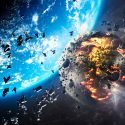Jupiter is home to some big storms. Like the massive Great Red Spot, which has been swirling on the gas giant for centuries. Why don’t we bring it to Earth and see what happens? How long would this megastorm rage? How would it blow the socks off every other storm our planet has ever seen? And why would you want to be at the center of it all?
The Great Red Spot is the largest storm in our Solar System and it’s responsible for giving Jupiter its iconic, erm, great red spot. Spanning 16,000 km (10,000 mi) across, this storm is nearly 1.5 times wider than Earth. And it reaches towering heights of 500 km (310 mi) into Jupiter’s atmosphere. Scientists have been able to observe this storm for 200 years now.
Though it’s likely that the storm is much, much older than that. More recently, the Great Red Spot appears to be changing shape and shrinking. But whether it’s getting smaller or not, how would this great storm look on Earth? Would our entire planet, from surface to space, be blanketed in a storm that would rage on forever?
The Great Red Spot isn’t the only storm on Jupiter. But hauling over all the gas giant’s storms would be a little too devastating for our planet. You’d see massive cyclones on both the North and South poles if you did. And those big bad cyclones would be surrounded by several smaller cyclones. Though smaller wouldn’t mean much compared to you might be used to.
They would have wind speeds that reach up to 350 km/h (220 mph) and be about 1.5 times stronger than a Category 5 hurricane. The Great Red Spot on its own would be more than Earth could really handle anyway. This storm is so tall that it would reach the International Space Station. That’s more than 400 km (248 mi) straight up.
In total, this massive storm would cover about 40% of the Earth’s surface. And given what we already know about its existence, it wouldn’t appear to be going away anytime soon. Scientists observed that on Jupiter, the Great Red Spot usually hovers at the same latitude. That’s because it’s likely held in place by two cloud bands in the planet’s mostly hydrogen and helium atmosphere.
If this happened here on Earth, the unlucky countries that fall along this line of latitude would be plagued by this forever storm. Imagine the Great Red Spot perpetually orbiting around the equator. If you lived somewhere like Brazil, Uganda or Indonesia, you’d have to be constantly on the move. You’d need to stay within the eye of the storm. Or else.
At least in there, you’d be dealing with some relative calm compared to what’s going on around it. On its outermost edges, the winds of the Great Red Spot would reach speeds between 430-680 km/h (270-425 mph). Even at the low end of that, these winds would be twice as fast as the strongest hurricanes on Earth. But what a sight it would be to gaze at this storm from a distance.
You’d see a tower of clouds reaching all the way up to space. Wherever it hovers, it would block out sunlight, potentially lowering temperatures around the globe. Not much within the storm’s path would stand a chance of survival. This goes beyond trees and your home being swept away. Skyscrapers and highrises are the last places you’re going to want to be.
It would release unprecedented amounts of rain, displace millions of people and could result in a never-ending series of devastating mudslides and floods. It would be so powerful that several smaller but still devastating storms could form around its edges, creating even more chaos. But could the Great Red Spot really rage on forever and ever? Well thankfully on Earth, it likely wouldn’t.
When large hurricanes form over warm ocean water, they pick up strength until they make landfall. At this point, they lose their primary fuel source, moisture. On a gaseous planet like Jupiter, the Great Red Spot doesn’t stop because it doesn’t have any continents to collide with to rain on its stormy parade.
And while you may know this storm by its iconic red color, it wouldn’t necessarily stay red on Earth. Since our atmosphere mostly consists of nitrogen, oxygen and other trace elements, it could appear blue or white-ish to you. So maybe it would be best to keep the Great Red Spot right where it is. You’ve already got enough to worry about with all the destructive storms right here on Earth.
Sources
- “The Shape Of Jupiter’S Great Red Spot Is Changing. Here’s Why.”. Rae Paoletta. 2021. planetary.org.
- “Jupiter’s Great Red Spot Is Even Deeper Than Scientists Had Thought”. Rahul Rao. 2021. space.com.
- “Jupiter’s Great Red Spot Is 40 Times Deeper Than Mariana Trench”. Brandon Specktor. 2021. livescience.com.
- “These Storms On Jupiter Are Way Better Than Any Hurricane On Earth”. Miriam Kramer. 2018. mashable.com.
- “Saffir-Simpson Hurricane Wind Scale”. 2022. nhc.noaa.gov.



























